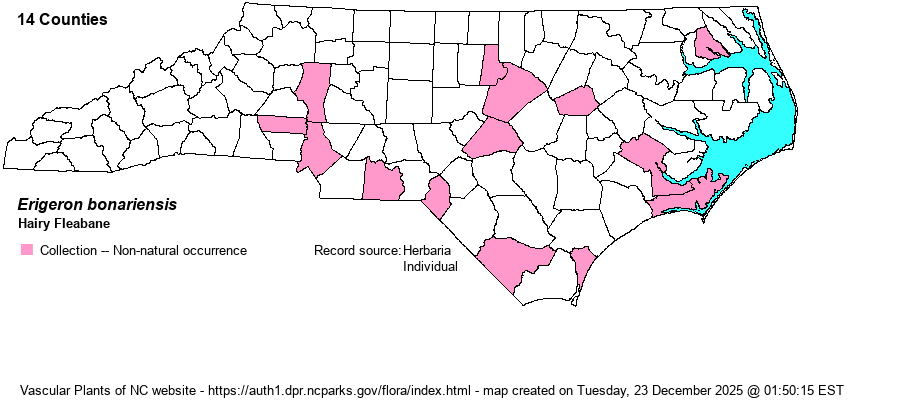| Author | L. | |
| Distribution | Scattered locations in the Piedmont and Coastal Plain, with large gaps. A curiously localized plant that may produce large populations, but which seems to be a poor disperser. First collected in 1949 in Carteret and New Hanover counties.
Native of South America ("bonariensis" means of Buenos Aires, Argentina); in N.A. in the southern U.S. from VA to FL, TX, CA; also UT, OR, WA. | |
| Abundance | Rare on the landscape, but individuals can number in the hundreds. | |
| Habitat | Pastures, barnyards, fallow fields, vacant lots, sidewalk, creek bank, pine savanna. The Scotland County specimen came from Tunstall's Bay. | |
| Phenology | Flowering and fruiting April-October. | |
| Identification | This fleabane grows 1-3 feet tall and is rather densely spreading-pubescent throughout. The lower leaves are lance-shaped, becoming linear up the stem. Of our other species of Erigeron, it most resembles Common Horseweed (E. canadensis) in its very short (less than 1 mm) or absent ray lamina (petal-like structures on the outer florets). It differs in its taller involucre and far more florets per head than C. canadensis -- thus appearing to have larger heads but fewer in number than that abundant native weed. In the field it also may appear gray-green in color. | |
| Taxonomic Comments | A synonym is Conyza bonariensis.
| |
| Other Common Name(s) | | |
| State Rank | SE | |
| Global Rank | G5 | |
| State Status | | |
| US Status | | |
| USACE-agcp | FACU link |
| USACE-emp | FACU link |

